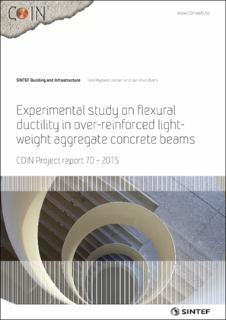| dc.description.abstract | This study focuses on ductility of lightweight aggregate concrete (LWAC) in compression. The major disadvantage of LWAC is the brittleness in compression at the material level compared to normal density concrete. Requirements for energy absorption and/or a controlled behaviour after peak load may exclude LWAC as the preferred material. In overload situations adequate ductility is essential to ensure safety. Floating offshore structures and LNG-terminals are often post-tensioned, e.g. to avoid leakage cracks in service. Thus the compressive ductility is of great importance. The influence of the stress-strain characteristics in compression is also more pronounced in structures subjected to combined bending moment and axial forces. Ductility of LWAC in compression plays an important part in improving the structural ductility in heavily reinforced and post-tensioned structures. Increase of the ductility in the compression zone in bending is possible by employing stirrups and/or fibre reinforcement to achieve passive confinement.
To study the ductility an experimental program was set up consisting of eight over-reinforced lightweight concrete beams with length 4200 mm and cross-section 400×350 mm, which were subjected to four-point bending. The beams were heavily over-reinforced to ensure spalling in the compression zone of the cross section before yielding of the tensile reinforcement. The LWAC had a mass density about 1800 kg/m3, with a compressive strength about 35 MPa. Four different confinement configurations of the compression zone of the beams were investigated - only LWAC, 1 % of steel fibre reinforcement, stirrups with spacing 100 mm, and a combination of fibre and stirrups. This report presents mainly the results from the experimental investigation of the beams, with focus on the flexural response. Especially the effect of the different confinement configurations is analysed in the plastic hinge region. However, also the obtained material properties of the LWAC, the fibre reinforced LWAC and the reinforcement are given. In addition the governing design assumptions employed for calculated load capacities are illustrated, and also the estimation of the displacement-, rotation- and curvature relationships.
The load at spalling of the concrete cover and the pre-peak response before initiation of spalling was approximately the same for all configurations. However, the effects of the different confinement configurations on the post-peak response are significant within the inelastic range of deformations, i.e. considerable improvement of the structural performance regarding ductility and load-carrying degradation. As expected, the reference beams with only LWAC in the compression zone, had a brittle post-peak response, i.e. no post-peak deformability and a very steep descending branch immediately after initiation of spalling of the concrete cover. The other beams, with different confinement configurations, were all capable of carrying load with quite large deflections, and also achieved a peak load after initiation of spalling.
Beams with fibre had a soft transition at spalling, with a steady flattening of the load-deformation relationship, before the peak load was achieved. Beams with stirrups show a reduced capacity after initiation of spalling, before the confinement effect of the stirrups was activated and the load capacity was increasing again towards the peak load. For these beams, with either fibre or stirrups in the compression zone, the peak load was achieved at a load approximately equal to the load at spalling, and with a displacement ductility index (μ2 = Δpeak/Δspall) of about 1,2. Beams with both fibre and stirrups had a soft transition at spalling, but also a gradual and significant capacity increase of approximately 10 % after initiation of spalling, and achieved a displacement ductility index (μ2 = Δpeak/Δspall) of about 1,5.
Beams with either fibre or stirrups experienced approximately the same post-peak response. However, the two beams with fibre had a large difference in the inclination of the descending branch after peak load. This can partly be explained by different fibre distribution and fibre orientation. For these beams the achieved displacement ductility index (μ3 = Δ0,9spall/Δspall), referred to as the ratio of the vertical mid span displacement at 90 % of the spalling load in the post-peak response to the displacement at spalling load, was about 1,8. Beams with both fibre and stirrups had a very ductile post-peak response, with a slight descending branch, and achieved a displacement ductility index (μ3 = Δ0,9spall/Δspall) of about 4,0, i.e. approximately doubled compared to the beams with either fibre or stirrups. Thus, the effect of using both fibres and stirrups was advantageous and significant with respect to ductility in the post-peak response, in addition to the ultimate capacity.
The results from this investigation are promising, and indicate that LWAC have potential to be consistent with the performance requirements for structural materials, also regarding ductility in heavily reinforced and post-tensioned structures in seismic areas. | en_US |
